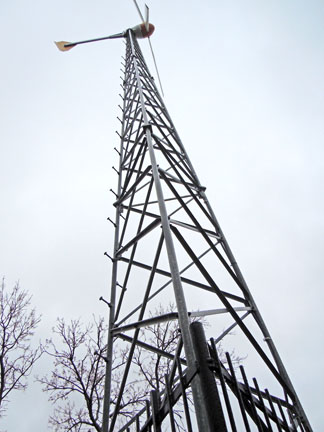Capturing the Power of Wind
Bruning couple powers home using residential wind turbine.

Like most retirees, making the “fixed” dollar go an extra mile is a concept to which Chauncey and Shirley Aksamit cleave. And like most of their peers believe, seeking out different methods of making incomes stretch further is just plain using your brain. But, how about if the method is taken one step further, say, converting something that’s given free into creating this ideal; for example, using the wind to make someone energy independent? Well, that’s a no-brainer.
“Self sufficiency, energy independence,” Chauncey says, “these are the things that will make the retirement dollar go further.”
Last year, February 2012, the Aksamits installed a 5kW wind turbine to meet the energy needs of their home in Bruning. And while the cost of the turbine and tower won’t be realized for a few years, the Aksamits note the savings in electricity each and every month. Says Chauncey, “In today’s market, you buy a wind turbine at today’s rate and pay your utility bill at today’s rate. My thought is that inflation may steadily increase utility prices, so buying a wind turbine today is a hedge against utility inflation, making the retirement dollar go further.”
The 5kW Bergey Wind Turbine, manufactured by Bergey Windpower in Norman, Okla., sits on a 60-foot self-supporting Rohn tower beside the Aksamit’s garage in Bruning. “The blades make it 75 feet tall,” Chauncey said and added that the turbine, tower, buried electrical lines, disconnects, batteries and other components and installation cost approximately $40,000. Marc Stevens, of Windfarmer Power & Light of Chadron, installed the turbine.
“Our home is heated and cooled with electricity created by the turbine,” Shirley says. “When the wind blows, we buy little or no electricity from Norris Public Power, and if we produce more electricity than we need, we sell to them.” (On the day of the interview, the Aksamits said they had purchased one kilowatt of power from Norris in a 24-hour period.) Batteries are used for storage; up to one month of electricity can be stored for use on days when the wind does not blow.
Today, residential wind energy is an increasingly sought means of creating electricity for independent living. People are often surprised that wind turbines are an option for a residential home and the availability of wind energy for the homeowner is a fast growing part of wind technology.
Wind turbines come in many shapes and sizes including horizontal axis types (like the Aksamit’s) or vertical axis types. The size of the wind turbine should be specific to the amount of watts or kilowatts that it can create for the building or buildings it will service.
Chauncey, a brick mason and building contractor by trade, and Shirley, who worked for 15 years with FDIC and ten years at State Bank of Alexandria, have always used electricity as the source of energy in their homes. In 1966, the couple purchased property near Alexandria State Lakes and built a new home and five rental cabins, all powered by electricity.
Had residential turbines been readily available back then, it’s a sure bet Chauncey and Shirley would have owned one to service the home and cabins. “A wind turbine is a smart investment that will lower your monthly electrical expenses, increase your net worth, and help support American manufacturing jobs,” Shirley says. “At the same time, it will help clean the air, slow climate change, and move us toward energy independence. The wind is still free.”




